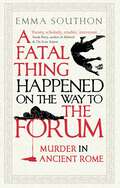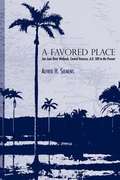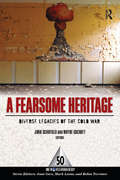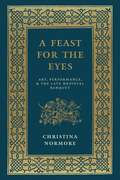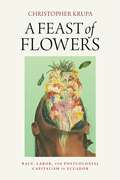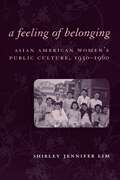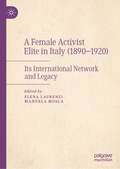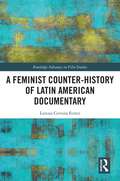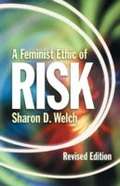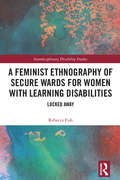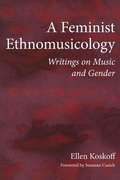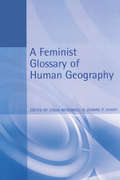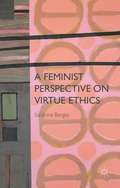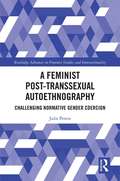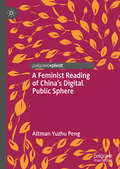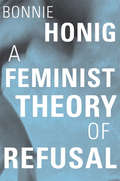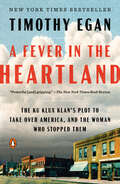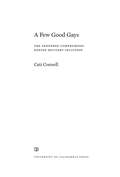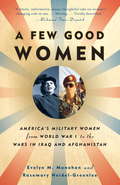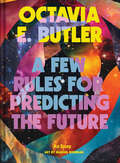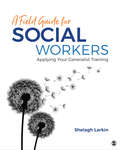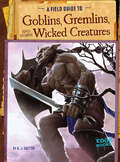- Table View
- List View
A Fatal Thing Happened on the Way to the Forum: Murder in Ancient Rome
by Emma SouthonIn Ancient Rome all the best stories have one thing in common – murder. Romulus killed Remus to found the city; Caesar was assassinated to save the Republic. Caligula was butchered in the theatre, Claudius was poisoned at dinner and Galba was beheaded in the forum. In one fifty-year period, twenty-six emperors were murdered. But what did killing mean in a city where gladiators fought to the death to sate a crowd? Emma Southon examines real-life homicides from Roman history to explore how perpetrator, victim and the act itself were regarded by ordinary people. Inside Ancient Rome&’s unique culture of crime and punishment, we see how the Romans viewed life, death, and what it means to be human.
A Favored Place: San Juan River Wetlands, Central Veracruz, A.D. 500 to the Present
by Alfred H. SiemensI doubt there is a wetland environment anywhere in the Americas inhabited, used, and modified as long as San Juan Basin, and by as many cultures with different technologies. This story needs to be told. --William E. Doolittle, Professor of Geography, University of Texas at Austin The wetlands of the San Juan Basin in Central Veracruz, Mexico, have been a favored place since the fifth century A. D. , when Prehispanic people built an extensive network of canals and raised fields that allowed for almost year-round agriculture. Alfred Siemens' discovery of the remains of this network in the 1970s led him to uncover fifteen centuries of land-use history in the region. This book contains a full record of his findings. Siemens organizes his history of the San Juan Basin around the question: What relationships exist between Prehispanic agriculture and the production systems of the tropical lowlands in our own time? This focus allows him to chart the changes in human perceptions and uses of the landscape, from the Prehispanic wetland agricultural system to the drained pastures of today's cattle ranches. Amplified with air oblique photography, maps, and tables, and enriched with data from archaeology and colonial archives, this is an authoritative historical geography of a wetland landscape. Or, in the author's more modest words, It seems to me that what I have here is a biography of a swamp.
A Fearsome Heritage: Diverse Legacies of the Cold War (One World Archaeology Ser. #50)
by John Schofield Wayne CocroftFrom massive nuclear test sites to the more subtle material realities of everyday life, the influence of the Cold War on modern culture has been profound and global. Fearsome Legacies unites innovative work on the interpretation and management of Cold War heritage from fields including archaeology, history, art and architecture, and cultural studies. Contributors understand material culture in its broadest sense, examining objects in outer space, domestic space, landscapes, and artistic spaces. They tackle interpretive challenges and controversies, including in museum exhibits, heritage sites, archaeological sites, and other historic and public venues. With over 150 color photos and illustrations, including a photographic essay, readers can feel the profound visual impact of this material culture.
A Feast for the Eyes: Art, Performance, and the Late Medieval Banquet
by Christina NormoreTo read accounts of late medieval banquets is to enter a fantastical world where live lions guard nude statues, gilded stags burst into song, and musicians play from within pies. We can almost hear the clock sound from within a glass castle, taste the fire-breathing roast boar, and smell the rose water cascading in a miniature fountain. Such vivid works of art and performance required collaboration among artists in many fields, as well as the participation of the audience. "A Feast for the Eyes"is the first book-length study of the court banquets of northwestern Europe in the fourteenth and fifteenth centuries. Christina Normore draws on an array of artworks, archival documents, chroniclers accounts, and cookbooks to re-create these events and reassess the late medieval visual culture in which banquets were staged. Feast participants, she shows, developed sophisticated ways of appreciating artistic skill and attending to their own processes of perception, thereby forging a court culture that delighted in the exercise of fine aesthetic judgment. Challenging modern assumptions about the nature of artistic production and reception, "A Feast for the Eyes"yields fresh insight into the long history of multimedia work and the complex relationships between spectacle and spectators. "
A Feast of Flowers: Race, Labor, and Postcolonial Capitalism in Ecuador
by Christopher KrupaWhen Ecuador's cut-flower industry took off in the mid-1980s, it rode a wave of international credit peddling and currency speculation that would lead countries of the Global South into successive debt crises and northern financial firms to fortune and dominion. By the start of the twenty-first century, as the Ecuadorian economy collapsed and its ties with international finance became strained, flower exporters rebuilt their businesses around the profitability of their indigenous labor force, drawing local communities deeply into new plantation systems taking over the highlands.In A Feast of Flowers, Christopher Krupa goes inside Ecuador's booming cut-flower industry to chronicle the ways its capitalist pioneers built a booming export industry around a racial ideology, turning indigenous people's purported differences into resources for industrial expansion. At the core of this racial system is a belief, central to postcolonial science and politics in Ecuador, in capitalism's unique capacity to change people's racial identity and to liberate oppressed populations from racial subordination. Krupa shows how such views not only guide how indigenous people are today incorporated into demanding labor systems in Ecuador's new export plantations, but also how indigenous minds and bodies became sites of study and intervention by scientists, politicians, and economic planners throughout the last century, all looking to change indigenous people in some way.Combining nearly two decades of ethnographic and historical research, A Feast of Flowers shows how aggressive capitalist expansion in postcolonial contexts may revive longstanding intersections between race and economy to facilitate new modes of dispossession under the guise of humanitarian intervention.
A Feeling for the Organism: The Life and Work of Barbara McClintock
by Evelyn F. Keller W. H. FreemanBiography of the scientist, written in 1983 before she was awarded the Nobel Prize.
A Feeling of Belonging: Asian American Women's Public Culture, 1930-1960 (American History and Culture #3)
by Shirley Jennifer LimWhen we imagine the activities of Asian American women in the mid-twentieth century, our first thoughts are not of skiing, beauty pageants, magazine reading, and sororities. Yet, Shirley Jennifer Lim argues, these are precisely the sorts of leisure practices many second generation Chinese, Filipina, and Japanese American women engaged in during this time.In A Feeling of Belonging, Lim highlights the cultural activities of young, predominantly unmarried Asian American women from 1930 to 1960. This period marks a crucial generation—the first in which American-born Asians formed a critical mass and began to make their presence felt in the United States. Though they were distinguished from previous generations by their American citizenship, it was only through these seemingly mundane “American”activities that they were able to overcome two-dimensional stereotypes of themselves as kimono-clad “Orientals.”Lim traces the diverse ways in which these young women sought claim to cultural citizenship, exploring such topics as the nation's first Asian American sorority, Chi Alpha Delta; the cultural work of Chinese American actress Anna May Wong; Asian American youth culture and beauty pageants; and the achievement of fame of three foreign-born Asian women in the late 1950s. By wearing poodle skirts, going to the beach, and producing magazines, she argues, they asserted not just their American-ness, but their humanity: a feeling of belonging.
A Female Activist Elite in Italy (1890–1920): Its International Network and Legacy
by Manuela Mosca Elena LaurenziThis book explores and traces the progressive activism and radical ideas of several elite women in Italy beginning in the early 20th century. It discusses the shared political culture that shaped the thinking and the activity of these women, mainly oriented towards political philanthropy and work, seen as the cornerstone of a comprehensive redefinition of gender relations. It also discusses the connections linking them to an international network of women involved in similar political actions and economic initiatives addressing women’s' interests, as well as their legacy for the next generations. With essays from a range of scholars, this book provides an interdisciplinary framework for understanding these activists and deals with methodological and historiographical issues in reconstructing women’s contribution to history.
A Feminist Approach to Sensitive Research: Designing the Clay Embodiment Research Method (Focus on Global Gender and Sexuality)
by Tricia OngThis book explores the development and implementation of the Clay Embodiment Research Method (CERM) with one of the most stigmatized, oppressed, and marginalized groups of women in Nepal: sex-trafficked women. It argues for the use of a feminist approach to such research given the prevailing patriarchal norms, cultural sensitivity of reproductive health, stigmatization of sex trafficking, and low literacy of the women involved. Beginning with an exploration of the author’s relationship with Nepal and the women who guide the study, and the realization that a more accessible research approach was needed than the techniques otherwise commonly used, it discusses the use of clay and photography as ideal entry points to engaging with the women in the research and creating this ethical methodology for self-empowerment. Not only does the volume highlight extraordinary insights offered by the women involved in this study through the application of CERM, but also the recognition that its use requires expertise that can deal with the potential elicitation of trauma. The book makes the case for further study on improving the method’s use in research, education, and therapy involving low-literate, stigmatized, oppressed, and marginalized populations, particularly where cultural sensitivity is an important consideration. A Feminist Approach to Sensitive Research is suitable for students, scholars, and researchers in Gender Studies, Sociology, Health Studies, Anthropology, and Asian Studies.
A Feminist Counter-History of Latin American Documentary (Routledge Advances in Film Studies)
by Lorena Cervera FerrerA Feminist Counter-History of Latin American Documentary provides a new lens through which to revisit the history of Latin American cinema and proposes three approximations to the study of women’s documentary produced between the early 1970s and the mid-1990s.With a focus on documentaries with clear political intents, this book illustrates some of the thematic interests, authorial modes, production practices, formal devices, and aesthetic strategies employed by women filmmakers. Through analysis of the contexts, processes, and forms of a selection of films, the author shows how these non-fiction films shed light on the precarious conditions that characterised women’s greater entry into the workforce, on the circulation of feminist ideas, and on the inevitable questioning of identity that resulted from migration and displacement.This volume will appeal to scholars and students interested in women’s and feminist cinema, documentary history, theory, and practice, and Latin American history and culture.
A Feminist Ethic of Risk
by Sharon WelchA Feminist Ethic of Risk proposes a new model for ethics and new life orientation for social justice. It directly addresses American and European "middle-class despair" over issues and challenges seemingly too large to tackle, such as environmental destruction or racism. Her ethic uproots classical assumptions and opens up the possibility of a strong religious vision or "theology of resistance and hope." This new edition includes a new chapter that situates the feminist ethic of risk in relation to other styles and options in religious ethics today.
A Feminist Ethnography of Secure Wards for Women with Learning Disabilities: Locked Away (Interdisciplinary Disability Studies)
by Rebecca FishWhat is life like for women with learning disabilities detained in a secure unit? This book presents a unique ethnographic study conducted in a contemporary institution in England. Rebecca Fish takes an interdisciplinary approach, drawing on both the social model of disability and intersectional feminist methodology, to explore the reasons why the women were placed in the unit, as well their experiences of day-to-day life as played out through relationships with staff and other residents. She raises important questions about the purpose of such units and the services they offer. Through making the women’s voices heard, this book presents their experiences and unique perspectives on topics such as seclusion, restraint, and resistance. Exploring how the ever present power disparity works to regulate women’s behaviour, the book shows how institutional responses replicate women’s bad experiences from the past, and how women’s responses are seen as pathological. It demonstrates that women are not passive recipients of care, but shape their own identity and futures, sometimes by resisting the norms expected of them (within allowed limits) and sometimes by transgressing the rules. These insights thus challenge traditional institutional accounts of gender, learning disability and deviance and highlight areas for reform in policy, practice, methodology, and social theory. This ground-breaking book will be of interest to scholars, students, policymakers and advocates working in the fields of learning disability and disability studies more widely, gender studies and sociology.
A Feminist Ethnomusicology: Writings on Music and Gender
by Ellen Koskoff Suzanne CusickOne of the pioneers of gender studies in music, Ellen Koskoff edited the foundational text Women and Music in Cross Cultural Perspective, and her career evolved in tandem with the emergence and development of the field. In this intellectual memoir, Koskoff describes her journey through the maze of social history and scholarship related to her work examining the intersection of music and gender. Koskoff collects new, revised, and hard-to-find published material from mid-1970s through 2010 to trace the evolution of ethnomusicological thinking about women, gender, and music, offering a perspective of how questions emerged and changed in those years, as well as Koskoff's reassessment of the early years and development of the field. Her goal: a personal map of the different paths to understanding she took over the decades, and how each inspired, informed, and clarified her scholarship. For example, Koskoff shows how a preference for face-to-face interactions with living people served her best in her research, and how her now-classic work within Brooklyn's Hasidic community inflamed her feminist consciousness while leading her into ethnomusicological studies. An uncommon merging of retrospective and rumination, A Feminist Ethnomusicology: Writings on Music and Gender offers a witty and disarmingly frank tour through the formative decades of the field and will be of interest to ethnomusicologists, anthropologists, scholars of the history and development of feminist thought, and those engaged in fieldwork. Includes a foreword by Suzanne Cusick framing Koskoff's career and an extensive bibliography provided by the author.
A Feminist Glossary of Human Geography
by Linda McDowell Joanne P SharpA Feminist Glossary of Human Geography is the first guide to the main theories, concepts and terms commonly used in geographical debates about gender relations.Written by key contributors to feminist theory, it contains over 400 lively and accessible definitions of the terms found in feminist debates which students of geography need to know. Four levels of entry are used - from 50 to 1500 words - taking account of the varying degrees of complexity of the terms covered.From 'AIDS' to 'witch', from 'abortion' to 'whiteness', this 'Glossary' is cross-referenced throughout and includes a comprehensive bibliography. It is an invaluable reference for anyone studying geography and gender, enabling them to approach the terminology of feminist theory and ideas with confidence.
A Feminist Perspective on Virtue Ethics
by Sandrine BergesA Feminist Perspective on Virtue Ethics provides of historical survey of feminist virtue ethics, and shows how the ethical theorizing of women in the past can be brought to bear on that of women in the present.
A Feminist Post-transsexual Autoethnography: Challenging Normative Gender Coercion (Routledge Advances in Feminist Studies and Intersectionality)
by Julie Elizabeth PetersGender as a social class along with its concomitant heteronormative gender coercion seem to be intransigent across time and cultures. But across these cultures we also see a degree of nonconforming behaviour which very often carries significant multi-dimensions of stigma and risk; because the exception proves the rule, an understanding of gender nonconformity sheds light on the normative operation of gender in society. A Feminist Post-transsexual Autoethnography attempts to demythologise trans and gender diversity by conducting an in-depth critical analysis of the life choices of the autoethnographic subject (the author), who was so uncomfortable with their culturally allocated masculinity that they chose to live an apparently normal female life. The research is post-transsexual in that the subject forgoes passing in their affirmed gender to ensure the integrity of the data. A Feminist Post-transsexual Autoethnography may primarily appeal to students and researchers interested in the Sociology of Gender and Sociology of Trans and Gender Diversity, as well as the broader areas of embodiment and power differentials based on gender, class, nationality, location, temporality, sexuality and gender (non)conformity. This insightful volume may also be of interest to those within the fields Health Promotion and Education, Human Rights, Social Justice and Equity or the Social and Cultural Anthropology of Gender.
A Feminist Reading of China’s Digital Public Sphere
by Altman Yuzhu PengThis book makes an original contribution to the field of feminist cultural studies through an analysis of the gender-politics axis established in China’s digital public sphere. While a growing body of literature in contemporary feminist cultural studies has turned attention to the Chinese environment, scholarship remains limited in exploring the intersection of gender and politics in the context of Chinese digital cultures. This book addresses this timely topic. It will appeal to both scholars and students interested in exploring the complex, dynamic interplay between digital cultures, public expressions, as well as representations and perceptions of gender reflected in Chinese Internet users’ everyday communicative practice from a feminist media studies perspective.
A Feminist Theory of Refusal
by Bonnie HonigAn acclaimed political theorist offers a fresh, interdisciplinary analysis of the politics of refusal, highlighting the promise of a feminist politics that does not simply withdraw from the status quo but also transforms it. The Bacchae, Euripides’s fifth-century tragedy, famously depicts the wine god Dionysus and the women who follow him as indolent, drunken, mad. But Bonnie Honig sees the women differently. They reject work, not out of laziness, but because they have had enough of women’s routine obedience. Later they escape prison, leave the city of Thebes, explore alternative lifestyles, kill the king, and then return to claim the city. Their “arc of refusal,” Honig argues, can inspire a new feminist politics of refusal. Refusal, the withdrawal from unjust political and economic systems, is a key theme in political philosophy. Its best-known literary avatar is Herman Melville’s Bartleby, whose response to every request is, “I prefer not to.” A feminist politics of refusal, by contrast, cannot simply decline to participate in the machinations of power. Honig argues that a feminist refusal aims at transformation and, ultimately, self-governance. Withdrawal is a first step, not the end game. Rethinking the concepts of refusal in the work of Giorgio Agamben, Adriana Cavarero, and Saidiya Hartman, Honig places collective efforts toward self-governance at refusal’s core and, in doing so, invigorates discourse on civil and uncivil disobedience. She seeks new protagonists in film, art, and in historical and fictional figures including Sophocles’s Antigone, Ovid’s Procne, Charlie Chaplin’s Tramp, Leonardo da Vinci’s Madonna, and Muhammad Ali. Rather than decline the corruptions of politics, these agents of refusal join the women of Thebes first in saying no and then in risking to undertake transformative action.
A Fever in the Heartland: The Ku Klux Klan's Plot to Take Over America, and the Woman Who Stopped Them
by Timothy EganNEW YORK TIMES BESTSELLER • A Washington Post Notable Work of Nonfiction • An NPR Best Book of the Year • A Kirkus Reviews Best Book of the Year • A Chicago Review of Books Best Book of the Year • A New York Public Library Best Book of the Year • A Goodreads Choice Awards Finalist"With narrative elan, Egan gives us a riveting saga of how a predatory con man became one of the most powerful people in 1920s America, Grand Dragon of the Ku Klux Klan, with a plan to rule the country—and how a grisly murder of a woman brought him down. Compelling and chillingly resonant with our own time." —Erik Larson, author of The Splendid and the Vile&“Riveting…Egan is a brilliant researcher and lucid writer.&” —Minneapolis Star TribuneA historical thriller by the Pulitzer and National Book Award-winning author that tells the riveting story of the Klan's rise to power in the 1920s, the cunning con man who drove that rise, and the woman who stopped them.The Roaring Twenties--the Jazz Age--has been characterized as a time of Gatsby frivolity. But it was also the height of the uniquely American hate group, the Ku Klux Klan. Their domain was not the old Confederacy, but the Heartland and the West. They hated Blacks, Jews, Catholics and immigrants in equal measure, and took radical steps to keep these people from the American promise. And the man who set in motion their takeover of great swaths of America was a charismatic charlatan named D.C. Stephenson.Stephenson was a magnetic presence whose life story changed with every telling. Within two years of his arrival in Indiana, he&’d become the Grand Dragon of the state and the architect of the strategy that brought the group out of the shadows – their message endorsed from the pulpits of local churches, spread at family picnics and town celebrations. Judges, prosecutors, ministers, governors and senators across the country all proudly proclaimed their membership. But at the peak of his influence, it was a seemingly powerless woman – Madge Oberholtzer – who would reveal his secret cruelties, and whose deathbed testimony finally brought the Klan to their knees.A FEVER IN THE HEARTLAND marries a propulsive drama to a powerful and page-turning reckoning with one of the darkest threads in American history.
A Few Good Gays: The Gendered Compromises behind Military Inclusion
by Cati ConnellThe US military has done an about-face on gender and sexuality policy over the last decade, ending Don’t Ask, Don’t Tell, restrictions on women in combat, and transgender exclusion. Contrary to expectations, servicemembers have largely welcomed cisgender LGB individuals—yet they continue to vociferously resist trans inclusion and the presence of women on the front lines. In the minds of many, the embodied "deficiencies" of cisgender women and trans people of all genders puts others—and indeed, the nation—at risk. In this book, Cati Connell identifies the homonormative bargain that underwrites these uneven patterns of reception—a bargain that comes with significant concessions, upholding and even exacerbating race, class, and gender inequality in the pursuit of sexual equality. In this handshake deal, even the widespread support for open LGB service is highly conditional, revocable upon violation of the bargain. Despite the promise of inclusivity, in practice, the military has made room only for a "few good gays," to the exclusion of all others. But should equal access be the goal? How did we get from there to here? And where do we go next? In analyzing inclusion as a social movement aspiration, Connell shows that its steep price is exacted through the continued abjection of queered Others, both at home and abroad.
A Few Good Women: America’s Military Women from World War I to the Wars in Iraq and Afghanistan
by Evelyn M. Monahan Rosemary Neidel-GreenleeThe never-before-told story of the U. S. women's military corps: the women who fought for the right to defend their country by serving in the armed forces--a fight that continues today for American military women who want to serve in combat support positions.
A Few Rules for Predicting the Future: An Essay
by Octavia E. ButlerThe wise words of science fiction icon Octavia E. Butler live on in this beautiful and giftable little volume."There’s no single answer that will solve all our future problems. There’s no magic bullet. Instead there are thousands of answers—at least. You can be one of them if you choose to be."Originally published in Essence magazine in the year 2000, Octavia E. Butler’s essay "A Few Rules for Predicting the Future" offers an honest look into the inspiration behind her science fiction novels and the importance of studying history and taking responsibility for our actions if we are to move forward. Organized into four main rules, this short essay reminds readers to learn from the past, respect the law of consequences, be aware of their perspectives, and count on the surprises. Citing the warning signs of fascism, the illusive effects of fear and wishful thinking, and the unpredictable nature of what is yet to come, Butler shares realistic but hopeful suggestions to shape our future into something good. An inspiring and motivational gift for students and recent graduates, fans of Butler's work, and anyone seeking a brighter day tomorrow, this exquisite gift book includes stunning Afrofuturist artwork by Manzel Bowman alongside the full text of the original essay.LITERARY ICON: Octavia E. Butler was a pioneering science fiction writer whose novels, written decades ago, remain eerily relevant, reflecting on themes of racial injustice, women’s rights, environmental collapse, and political corruption. In 1995, she became the first science fiction author to win a MacArthur Genius grant, and her books are taught in over 200 colleges and universities nationwide. This book shares Butler's timely but lesser-known essay and is a must-read for fans of her classic sci-fi works. CELEBRATE BLACK CREATORS: This book spotlights one of the greatest authors of Afrofuturism, a genre and philosophy that explores and reimagines Black culture, creativity, and liberation through fiction, art, music, film, and other media. Octavia E. Butler’s forward-thinking essay is paired with contemporary illustrations by Manzel Bowman, whose evocative images are also inspired by Afrofuturist visions. INSPIRING GIFT: A unique gift for students, recent graduates, and anyone celebrating life milestones or looking forward in life, this beautifully designed hardcover book is sure to inspire. Octavia E. Butler’s essay is also an important, evergreen reminder for writers, creatives, dreamers, and activists who want to envision and work toward a brighter future.Perfect for:Fans of Octavia Butler and her novels, including Kindred and Parable of the SowerPeople interested in nonfiction and essays by Black women writersAfrofuturism lovers and social justice-minded sci-fi readersLiterary bibliophiles looking for a stunning new addition to their bookshelfGift-giving to graduating high school and college studentsActivists and community leadersInspirational essay readersFans of Manzel Bowman and Afrofuturist art
A Field Guide for Social Workers: Applying Your Generalist Training
by Shelagh J. LarkinIntegrating theory with practice, A Field Guide for Social Workers: Applying Your Generalist Training helps students understand and overcome the challenges of field education. This comprehensive text provides the necessary tools to develop and demonstrate core competencies set forth by the Council on Social Work Education (CSWE) using author Shelagh Larkin’s generalist field education approach grounded in generalist practice literature. Integrative activities and reflection questions directly apply generalist training to field experience. Students will be equipped to meet the goals of the field and realize their potential as generalist practitioners.
A Field Guide for Social Workers: Applying Your Generalist Training
by Shelagh J. LarkinIntegrating theory with practice, A Field Guide for Social Workers: Applying Your Generalist Training helps students understand and overcome the challenges of field education. This comprehensive text provides the necessary tools to develop and demonstrate core competencies set forth by the Council on Social Work Education (CSWE) using author Shelagh Larkin’s generalist field education approach grounded in generalist practice literature. Integrative activities and reflection questions directly apply generalist training to field experience. Students will be equipped to meet the goals of the field and realize their potential as generalist practitioners.
